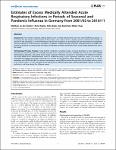Estimates of Excess Medically Attended Acute Respiratory Infections in Periods of Seasonal and Pandemic Influenza in Germany from 2001/02 to 2010/11
Heiden, Matthias an der
Köpke, Karla
Buda, Silke
Buchholz, Udo
Haas, Walter
Background: The number of patients seeking health care is a central indicator that may serve several different purposes: (1) as a proxy for the impact on the burden of the primary care system; (2) as a starting point to estimate the number of persons ill with influenza; (3) as the denominator data for the calculation of case fatality rate and the proportion hospitalized (severity indicators); (4) for economic calculations. In addition, reliable estimates of burden of disease and on the health care system are essential to communicate the impact of influenza to health care professionals, public health professionals and to the public. Methodology/Principal Findings: Using German syndromic surveillance data, we have developed a novel approach to describe the seasonal variation of medically attended acute respiratory infections (MAARI) and estimate the excess MAARI attributable to influenza. The weekly excess inside a period of influenza circulation is estimated as the difference between the actual MAARI and a MAARI-baseline, which is established using a cyclic regression model for counts. As a result, we estimated the highest ARI burden within the last 10 years for the influenza season 2004/05 with an excess of 7.5 million outpatient visits (CI95% 6.8–8.0). In contrast, the pandemic wave 2009 accounted for one third of this burden with an excess of 2.4 million (CI95% 1.9–2.8). Estimates can be produced for different age groups, different geographic regions in Germany and also in real time during the influenza waves.
No license information

